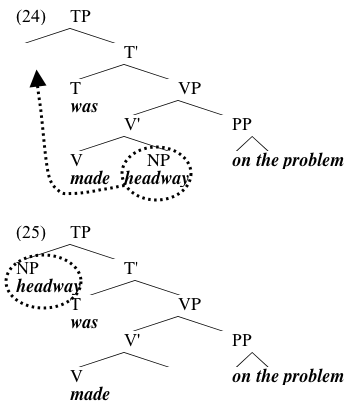
(1) We paid heed to her warnings.
(2) We made headway on the problem.
(3) The FBI is keeping tabs on me.
All of the objects in the sentences above could be replaced by synonymous expressions. For example, if you changed heed in (1) to attention, the resulting sentence would mean more or less the same thing. Similarly, headway seems to mean progress, more or less, and tabs means something like a close watch:
(4) We paid attention to her warnings.
(5) We made progress on the problem.
(6) The FBI is keeping a close watch on me.
However, the italicized objects in (1-3) have a more constrained distribution than their synonyms in (4-6). Take heed and attention, for example; you can do a lot of things with attention, but basically all you can do with heed is pay or take it:
(7) We directed our attention to the center ring.
(8) He's just trying to get your attention.
(9) Your behavior is attracting unwelcome attention.
(10) *We directed our heed to the center ring.
(11) *He's just trying to get your heed.
(12) *Your behavior is attracting unwelcome heed.
You can construct similar examples with make headway and keep tabs. So what we're seeing here is that in order to be interpreted at all, the objects in (1-3) have to be combined with particular verbs. We call verb-object pairs of this type, which have a special meaning just when they're combined with each other, idioms (and their parts, like the verb and the object in the examples we're looking at, are often called idiom chunks). Idioms come in many different sizes, including entire sentences (as in (13-14)) and NPs (as in (15)):
(13) The shit hit the fan.
(14) The jig is up.
(15) We visited the Big Apple.
Again, the italicized phrases have special meanings that don't follow directly from the meanings of their parts; if you're learning English, even if you know all the words in (13), you won't know that it means something like 'an anticipated catastrophe finally occurred' unless someone tells you so.
We have seen that idioms can consist of verbs and their objects (as in (1-3)), and also of larger constituents (as in (13-14)), and of smaller ones (as in (15)). In fact, it would almost be correct to say that idioms must always be constituents. In any event, there seem not to be many idioms consisting of a subject and a verb, to the exclusion of the object. For instance, none of the following sentences have idiomatic meanings:
(16) The armadillo bit John.
(17) Puppies nuzzled Susan.
(18) The llama ignored Phil.
The examples in (16-18) have literal meanings, of course, but none of them have idiomatic meanings. Moreover, there seem not to be idioms of this form; we find many idioms consisting of a verb and its object (as in (1-3)), but not of a verb with its subject.
Now, let's return our attention to the idioms in (1-3). We've seen that these idioms consist of verbs together with their objects; pay heed, make headway, keep tabs on. One reason for thinking that the verb is included in these idioms is that you can't combine the objects in these idioms with other verbs; that's what the data in (7-12) were supposed to show. And, as we might expect, these objects can't just be subjects of random verbs, either:
(19) Attention is always nice.
(20) *Heed is always nice.
On the other hand, there is one type of example in which these idiom chunks can in fact be subjects; you can make passive versions of the examples in (1-3):
(21) Heed was paid to her warnings.
(22) Headway was made on the problem.
(23) Tabs were kept on me by the FBI.
These examples seem like counterexamples to everything we've figured out about idioms so far. Idioms are not supposed to consist of subjects and verbs, and yet here, they do. These particular idiom chunks are definitely supposed to be unable to be subjects; they have to be objects of the particular verbs which are parts of their idioms. And yet, here, all of these rules are disobeyed. What is going on?
On an approach to the passive which posits movement, we can account for what is going on straightforwardly. A sentence like the one in (22) starts out with the tree in (24), which is converted via movement to the tree in (25):

The requirement that the idiom chunk headway become the object of make in order to form an idiom is satisfied in (24); subsequent movement obscures the structure of the idiom.
|
Optional Readings: There's a lot of work on idioms. Here are a few papers you might enjoy: Egan, Andy. 2008. Pretense for the complete idiom. Noûs 42:381-409. McGinnis, Martha. 2002. On the systematic aspect of idioms. Linguistic Inquiry 33.665-672. Richards, Norvin. 2001. An idiomatic argument for lexical decomposition. Linguistic Inquiry 32.183-192. |
Back to A-movement.